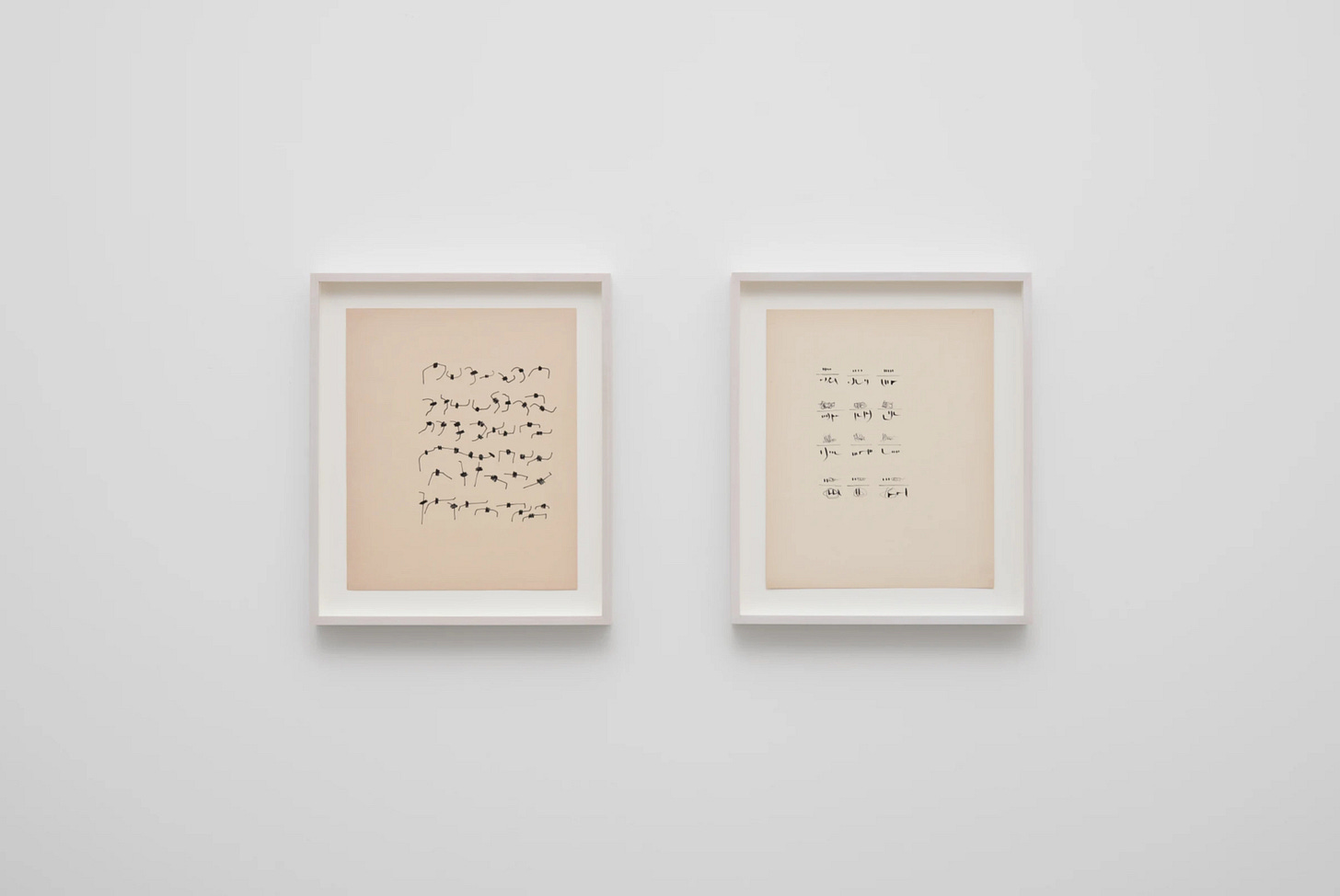This week, I took advantage of the good weather in London to venture central to Edel Assanti. The gallery is currently exhibiting Each Place its Own Mind, a show that portrays all the complexity and conceptual thought process suggestive of Edel Assanti’s program.
The exhibition borrows its name from David Abram’s The Spell of the Sensuous: Perception and Language in a More than Human World (1996). A cultural ecologist and philosopher, Abrams has travelled the world, studying the natural and the links that we have lost to it. He proposes that through advances such as phonetics and written language, we have dulled our ability to listen to the many-pronged languages and stories of the flora and fauna that we cohabitate.
In the first room of the gallery, I am greeted by the ambiguous messages of Mirtha Demisache. Asemic writing works evoke an array of memories and cultures through different pictorials and swooping lines. A particularly pokey piece at the edge of the rooms grins out at me and catches me off guard. The lines are so sharp in places I am reminded of barbed wire, if it were alive and chattering away.
Mirtha Demisache, Asemic Writing, 1970.
Abram prefers these representative texts over our phonetic languages of the present. With the riddance of hieroglyphics, we no longer read a sentence and see a picture of a snake, or a mountain. The surrounding world is not reflected in our language and behaviour, as we become further focused on our own species. This cycle is a core feature in Each Place Its Own Mind. In the next room lies Marguerite Humeau’s The Brewer, 2023, a fluid, glossy, spinning top, positioned perfectly in the center of the floor. Its surface gleams like mother of pearl as it reflects the work around it. In the corner of the room are two concrete busts who face one another, sharing secrets, except their faces are nothing more than resting places for honeycomb interiors, carefully crafted by bees and artist Anna Hulačová during honey season. This hive mind mentality is reflected in the paintings across the room, depicting bright cheery yellow that encompasses the immensity of the landscape artist Yukultji Napangati works to paint.
As a response to Descartes’ famous ‘I think, therefore I am’, Abram places in position a new consideration: ‘You are, therefore I am.’ One of my favorite pieces in this show was Exclusion Zone, 2024, a beautiful painting by Kat Lyons of two boars in a forest that utilised a breathtaking colour palette comprised of largely greens and reds for a striking effect. This painting truly felt like a full circle. The boars were just as brilliantly emerald as the trees, and the scarlet leaves that fell to the floor reabsorbed into the roots in shades of brown, before pushing back out of a ruby toned trunk.
Front: Anna Hulačová, Dialog: Bugonia V. (2024) Back: Kat Lyons, Exclusion Zone. (2024).
This exhibition circulates around our relationship to nature, and its approach is sometimes aspirational, but at its core objective. Although the focus is on the sounds of the wild, I mostly hear audio playing from the next room, where I hear human narrators, and AI configured voices. The subtle stratification of photography and video in Noémi Goudal’s White Pulse (2023) and Emmanuel Van Der Auwera VideoSculpture brings to life the misleading connections and vulnerabilities that friendships and relationships with technology can create. Through faintly robotic voices and genuine testimonies, I can still make out the crying of seagulls and the sounds of waves crashing.
The exhibition’s lower floor touches a more somber note, addressing the growing divide between humans and the natural world through a distinct acknowledgment of grief. In Sky Hopinka’s Fainting Spells (2018), the ties between the Ho-Chunk Nation and their land are uncovered, as the viewer hears the stories of loss and the return to a spiritual place. The film hosts a form of “inter-conversation” between the land and the artist, who takes time to appreciate the quiet messages and remembrances of Xąwįska.
Front: White Pulse. Noémi Goudal. Back: VideoSculpture. Emmanuel Van Der Auwera
The dialogue that takes place at the core of Fainting Spells is a notable example of the living ecosystem that Abram would like to see humans participate actively in. He discusses cycles and migration patterns throughout species, and underlines how these patterns are valued for their necessity, likening them to the earth’s inhaling and exhaling. Abram appreciates how these mass-migrations cross many human territories, pushing over drawn boundary lines to move with the seasons. Why then, can our own species not act as humbly? These polar separations between human and animal create a precedent for division that push forward a narrower geographical mindset in relation to diasporic change.
Each Place its Own Mind had a rich narrative to explore, with an array of pathways to follow in relation to questions posed about our own relationship to the natural world. Most of all, it made me appreciate the birds singing on my way back home.
*Pictures courtesy of Edel Assanti.








Interesting- “we have dulled our ability to listen to the many-pronged languages and stories of the flora and fauna that we cohabitate.” I wonder what Abram would say about abstract paintings? Thank you for this thoughtful review.